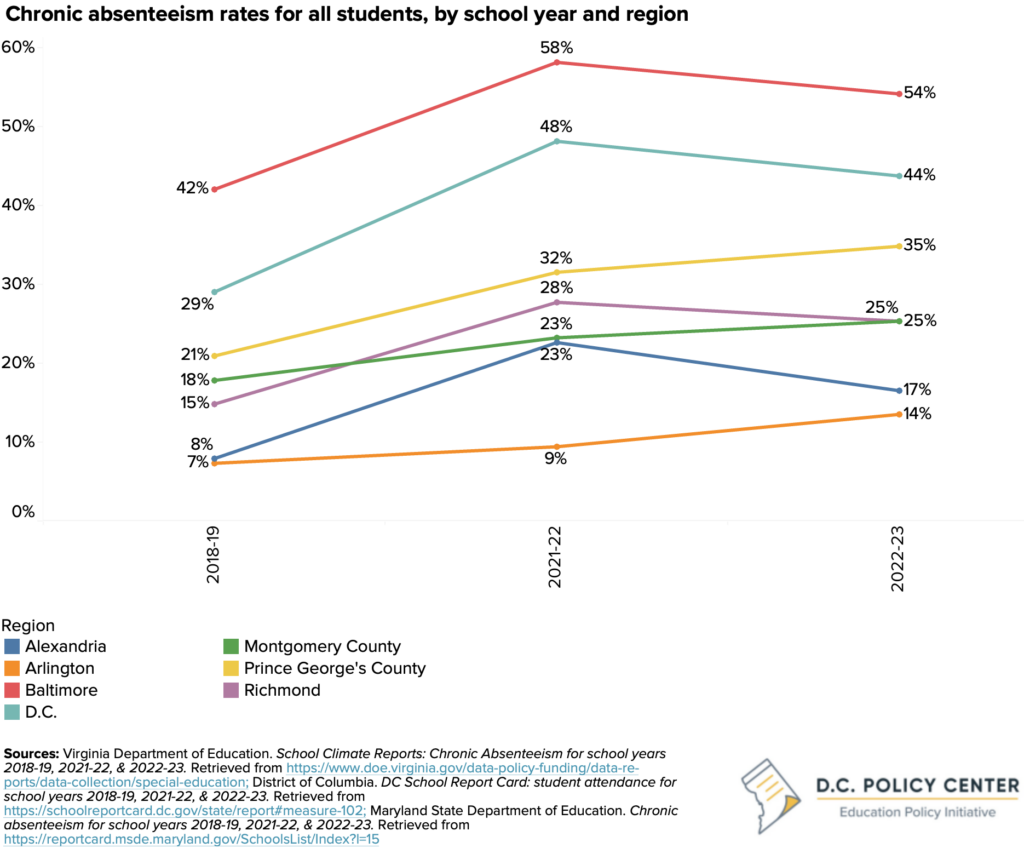
On Wednesday, June 26, 2024, Senior Education Research Analyst Hannah Mason testified before the D.C. Council Committee of the Whole at its attendance hearing. Her testimony focuses on chronic absenteeism rates in D.C. and surrounding areas and how to address truancy through evidence-based strategies. You can read her testimony below, or download a PDF copy.
Compared to neighboring counties and closest cities, D.C. has one of the highest chronic absenteeism rates, which includes excused absences and unexcused absences that count toward truancy. In Maryland, where attendance requirements are similar to D.C. at half of the day to be counted present, Baltimore’s chronic absenteeism rate of 54 percent in school year 2022-23 is higher than D.C.’s rate of 44 percent.1 This also holds true pre-pandemic, where 42 percent of students in Baltimore were chronically absent in school year 2018-19 compared to 29 percent in D.C. Neighboring Montgomery and Prince George’s counties in Maryland have lower chronic absenteeism rates than D.C. both pre and post pandemic.2 In Virginia, school districts set their own attendance policies, and chronic absenteeism is lower than both Maryland and D.C. for neighboring counties and the city of Richmond.3

In the most extreme cases of truancy, UPLIFT would require the Office of the Attorney General (OAG) to send parents whose child has accrued 25 unexcused absences one of the following: a letter that could subject them to prosecution; a referral to mandatory participation in the alternatives to the court experience diversion program; or a referral for mandatory participation by the family in a family group conference with the Youth Division of the Department of Health Services (DHS). However, research suggests there are other options aside from legal penalties for families that have been shown to reduce chronic absenteeism, which in part leads to decreasing unexcused absences that lead to truancy.
For example, mentoring, early warning systems, and weekly meetings have been effective elsewhere. Implementing mentoring programs, even low-cost ones, led to improving academic achievement for students in urban districts and decreasing absenteeism.4 Early warning systems, an approach that identifies and supports students who are at risk of failing an educational milestone, reduced absenteeism, improved student’s grade point averages, and decreased the number of students repeating a grade.5 The New York Department of Education (DOE) implemented a taskforce that reached 10,000 at-risk students by:
- organizing weekly meetings between principals and stakeholders to analyze student attendance data
- creating mentoring programs for students
- increasing incentives for students
- implementing higher accountability standards
- adjusting interventions in real-time for students based on data
This resulted in students participating in the above mentoring programs and receiving interventions significantly outperforming those who did not in terms of fewer absences, higher grade point averages, and higher rates of persistence through school.6
Like D.C., neighboring districts and schools have tiered intervention strategies when it comes to addressing truancy. In Baltimore, the school determines if students should be referred to the district office after missing 15 days of school without a legal reason.7 8Montgomery County implements a truancy prevention program comprised of multiple stakeholders that runs for 10 weeks and requires students to meet with mentors, establish attendance and academic goals, and successful completion of the program graduates students from the program.9 Prince George’s County’s truancy prevention programs include multiple components that are labeled as interventions and preventions.10 11 Alexandria public schools have an attendance plan created after a student accrues five unexcused absences.12 13 Arlington has similar policies as Alexandria with creating an attendance plan after five unexcused absences, an attendance conference after the seventh unexcused absence, and a multi-disciplinary team monitoring the student’s attendance.14 15
D.C. can increase attendance rates without punishing families. High school students especially have struggled with attendance and truancy across multiple years. The statute already requires that students be referred to the OAG’s office after 15 unexcused absences, yet absenteeism and truancy rates are at all-time highs. To ensure our students are succeeding in and beyond high school, we need a multi-faceted approach that evaluates what’s working to improve attendance and researching best practices all while holding families and students accountable in equitable ways.
Endnotes
- Maryland State Department of Education. Chronic absenteeism for school years 2018-19, 2021-22, & 2022-23. Retrieved from https://reportcard.msde.maryland.gov/SchoolsList/Index?l=15
- Maryland State Department of Education. Chronic absenteeism for school years 2018-19, 2021-22, & 2022-23. Retrieved from https://reportcard.msde.maryland.gov/SchoolsList/Index?l=15
- Virginia Department of Education. School Climate Reports: Chronic Absenteeism for school years 2018-19, 2021-22, & 2022-23. Retrieved from https://www.doe.virginia.gov/data-policy-funding/data-reports/data-collection/special-education
- May, J. J., Conway, D. M., & Guice, A. D. (2021). Follow the money or follow the mentors? The impact of mentoring on absenteeism and achievement in high poverty schools. Retrieved from https://eric.ed.gov/?id=EJ1294398
- Faria, A.-M., Sorensen, N., Heppen, J., Bowdon, J., Taylor, S., Eisner, R., & Foster, S. (2017). Getting students on track for graduation: Impacts of the Early Warning Intervention and Monitoring System after one year. U.S. Department of Education, Institute of Education Sciences, National Center for Education Evaluation and Regional Assistance, Regional Educational Laboratory Midwest. https://files.eric.ed.gov/fulltext/ED573814.pdf
- Balfanz, R & Byrnes, V. 2013. Meeting the challenge of combating chronic absenteeism. Retrieved from https://www.attendanceworks.org/wp-content/uploads/2017/09/NYC-Chronic-Absenteeism-Impact-Report-Nov-2013.pdf
- Baltimore City Public Schools. Attendance. Retrieved from https://mondayswimwear.com/products/monte-carlo-tie-dress-cypress-lurex-lace-crochet
- Baltimore’s policy states that if the district determines that the school has made every effort to work with families and provide support and the students continues to miss schools, charges will be filed against the family.
- Montgomery County Public Schools. 2023. Briefing: Attendance and Truancy in Montgomery County Public Schools. Retrieved from https://montgomerycountymd.granicus.com/MetaViewer.php?view_id=169&event_id=15966&meta_id=167344
- These components include but are not limited to attendance plans, parental contact, home visits, referrals to the schools’ student intervention team, and referrals to alternative education programs.
- Prince George’s County Public Schools. 2024. Chronic absenteeism and truancy: truancy study workgroup. Retrieved from https://pgccouncil.us/DocumentCenter/View/10791/Presentation—Chronic-Absenteeism-and-Truancy-April-12-2024
- In Alexandria, students may be withdrawn from school after 15 consecutive days, and students may be referred to Alexandria’s Court Attendance Review Panel. In extreme cases, charges may occur.
- Alexandria City Public Schools. Attendance regulations. Retrieved from https://resources.finalsite.net/images/v1656548553/acpsk12vaus/xsgqqewvguwycabe6lb9/JEA-R-JED-R-AttendanceRegulationsPDF.pdf
- In cases where either the student or family are intentionally non-compliant, the school may refer the student to the attendance officer which allows the officer to file a complaint with the juvenile district court and institute proceedings against the parent.
- Arlington Public Schools. Policy J-5.1.30. Attendance. Retrieved from https://go.boarddocs.com/vsba/arlington/Board.nsf/files/CEQKRJ52C268/$file/J-5.1.30%20Attendance.pdf
